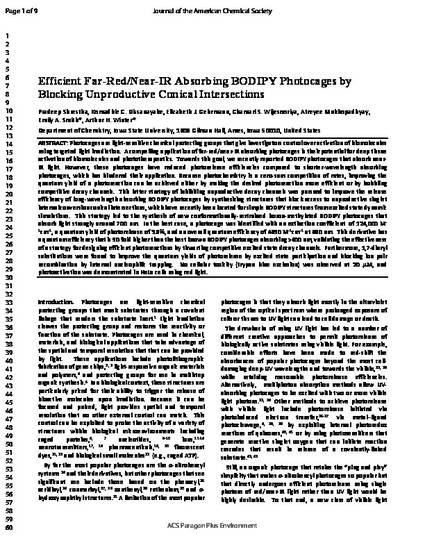
Photocages are light-sensitive chemical protecting groups that give investigators control over activation of biomolecules using targeted light irradiation. A compelling application of far-red/near-IR absorbing photocages is their potential for deep tissue activation of biomolecules and phototherapeutics. Towards this goal, we recently reported BODIPY photocages that absorb near-IR light. However, these photocages have reduced photorelease efficiencies compared to shorter-wavelength absorbing photocages, which has hindered their application. Because photochemistry is a zero-sum competition of rates, improving the quantum yield of a photoreaction can be achieved either by making the desired photoreaction more efficient or by hobbling competitive decay channels. This latter strategy of inhibiting unproductive decay channels was pursued to improve the release efficiency of long-wavelength absorbing BODIPY photocages by synthesizing structures that block access to unproductive singlet internal conversion conical intersections, which have recently been located for simple BODIPY structures from excited state dynamic simulations. This strategy led to the synthesis of new conformationally-restrained boron-methylated BODIPY photocages that absorb light strongly around 700 nm. In the best case, a photocage was identified with an extinction coefficient of 124,000 M-1cm-1, a quantum yield of photorelease of 3.8%, and an overall quantum efficiency of 4650 M-1cm-1 at 680 nm. This derivative has a quantum efficiency that is 50-fold higher than the best known BODIPY photocages absorbing >600 nm, validating the effectiveness of a strategy for designing efficient photoreactions by thwarting competitive excited state decay channels. Furthermore, 1,7-diaryl substitutions were found to improve the quantum yields of photorelease by excited state participation and blocking ion pair recombination by internal nucleophilic trapping. No cellular toxicity (trypan blue exclusion) was observed at 20 μM, and photoactivation was demonstrated in HeLa cells using red light.
Available at: http://works.bepress.com/arthur_winter/38/

This document is the unedited Author’s version of a Submitted Work that was subsequently accepted for publication in Journal of the American Chemical Society, copyright © American Chemical Society after peer review. To access the final edited and published work see DOI: 10.1021/jacs.0c07139. Posted with permission.